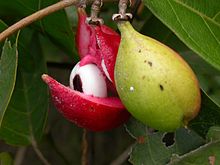
Summary
Paullinia pinnata is a flowering plant species in the genus of Paullinia found in South America and Africa.
| Paullinia pinnata | |
|---|---|

| |
| inflorescences of Paullinia pinnata, near La Forêt classée de Patako, Senegal | |
| Scientific classification | |
| Kingdom: | Plantae |
| Clade: | Tracheophytes |
| Clade: | Angiosperms |
| Clade: | Eudicots |
| Clade: | Rosids |
| Order: | Sapindales |
| Family: | Sapindaceae |
| Genus: | Paullinia |
| Species: | P. pinnata
|
| Binomial name | |
| Paullinia pinnata | |
The long flexible stems of P. pinnata are used to poison fish in shallow pools, as described by the English naturalist Henry Walter Bates in his book The Naturalist on the River Amazons.[1]

Chemistry edit
The plant contains the ceramide paullinomide A, β-amyrin, steroids, the coumarinolignoid 2-(4-hydroxy-3,5-dimethoxyphenyl)-3-hydroxymethyl-2,3-dihydro-1,4,5-trioxaphenanthren-6-one, 5α-poriferastane-3ß,6α-diol and l-quebrachitol.[2] It also contains the triterpenoids lupeyl steryl ether, 3-oxo-11α-hydroxyl-20(29)lupen and the lupeol-3-isovanniloyl ester paullinoyl (3-O-isovanilloyl-3R,5R,8R,9R,10R,13R,14S,17S,18R,19R-lup-20(29)-en),[3] and the flavone glycosides diosmetin-7-O-(2‘ ‘-O-β-d-apiofuranosyl-6‘ ‘-acetyl-β-d-glucopyranoside) and tricetin-4‘-O-methyl-7-O-(2‘ ‘-O-β-d-apiofuranosyl-6‘ ‘-acetyl-β-d-glucopyranoside).[4]
Ecology edit
A number of lepidopteran larvae (Morpho polyphemus, Fresna nyassae, Neptis trigonophora, Brenthia elongata, Charaxes lycurgus, Charaxes zelica, Euphaedra medon, Euphaedra harpalyce, Neptis clarei, Neptis nysiades, Neptis rogersi, Neptis troundi) feed on P. pinnata.
References edit
- ^ Bates, H. W. (1864). The naturalist on the River Amazons, a record of adventures, habits of animals, sketches of Brazilian and Indian life and aspects of nature under the Equator during eleven years of travel. London: J. Murray. Second edition. (Reprinted in paperback facsimile, Elibron Classics, 2005.) Page 242.
- ^ Chemical Constituents of Klainedoxa gabonenses and Paullinia pinnata. Etienne Dongo, Hidayat Hussain, Renadin S. Miemanang, Dagobert Tazoo, Barbara Schulz and Karsten Krohn, Rec. Nat. Prod., 2009, volume 3, issue 3 , pages 165–169 (article)
- ^ New triterpene isovanniloyl and antibacterial activity of constituents from the roots of Paullinia pinnata Linn (Sapindaceae)A.A. Lasisi, B.W. Ayinde, A.O. Adeleye, P.A. Onocha, I.A. Oladosu and P.A. Idowu, Journal of Saudi Chemical Society, doi:10.1016/j.jscs.2011.12.012
- ^ Two New Flavone Glycosides from Paullinia pinnata. Ehab A. Abourashed, Ngeh J. Toyang, John Choinski Jr. and Ikhlas A. Khan, J. Nat. Prod., 1999, volume 62, issue 8, pages 1179–1181, doi:10.1021/np990063z
External links edit
- Dressler, S.; Schmidt, M. & Zizka, G. (2014). "Paullinia pinnata". African plants – a Photo Guide. Frankfurt/Main: Forschungsinstitut Senckenberg.


